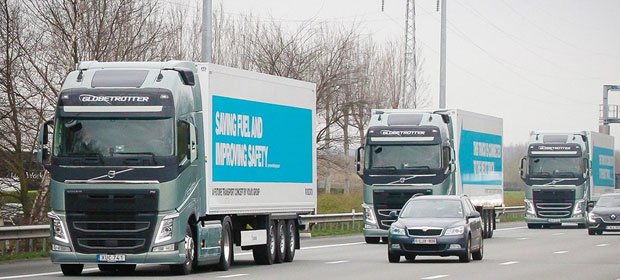Dozens of self-driving trucks arrived Wednesday in Rotterdam, Netherlands, after traveling across Europe in the European Truck Platoon Challenge.
The Dutch Ministry of Infrastructure and Environment, along with the Directorate General of the Rijkswaterstadt, the Netherlands Motor Vehicles Authority and the Conference of European Road Managers, were behind this initiative, which equipped a number of trucks with the latest driving support systems. To create more efficient commercial vehicles.
The European Truck Platoon Challenge featured six truck brands starting from three locations.
The Scania trucks left south of Stockholm and headed through Sweden, Denmark and Germany before arriving in Rotterdam. Volvo started its journey in Gothenburg and traveled through the same countries, and Iveco departed from Brussels. Daimler, MAN and VAF also participated.
Each platoon drove on European highways under normal traffic conditions.
This project is designed to create a system that allows commercial trucks to closely follow each other, reducing drag, improving safety and potentially creating economic growth in the traffic and transportation sector.
Each of the test vehicles was connected via WiFi, allowing for close platooning that would not be possible with human drivers.
The train is on the road
In essence, Platoon is a throwback to the era of rail transport – but with the freedom to go further than where the tracks were laid.
“This system makes trucks drive behind each other so drag is reduced, as truck platooning becomes more efficient,” said Peter Harrop, Chairman of IDTechEx.
“It’s like a railway train, but nothing is connected to each other, and this saves fuel and can therefore reduce pollution,” he told TechNewsWorld.
Harrop pointed out that the species is more applicable to Europe’s open highways than its crowded cities.
“This type of system cannot be easily used in cities where a group of madmen might attack you. But it solves the problem of congestion outside cities. You cannot build more roads because there is no room for it, and this allows you to use those existing roads more efficiently.”
Reduce costs
Another benefit of the system is that it can reduce trucking companies’ biggest expenses – drivers and fuel.
“This is truly the next proving ground for road transport and the associated cost reduction,” said Mariana Saenko, head of the Autonomous Systems Group at Lux Research.
“The biggest cost to trucking companies is the drivers and everything related to them,” she told TechNewsWorld, including insurance costs.
However, autonomous systems will not mean the end of drivers.
“Fully automated trucks are a way out, but even on the road the goal will not be to replace the driver but rather to enhance the driver’s capabilities,” Sainko added.
“No one plans for fuel to be cheap forever, and fuel costs are still a significant portion of trucking companies’ operational costs,” she noted.
Automated, not autonomous
The technology is still largely an ancillary feature, according to Jeremy Carlson, senior self-driving analyst at IHS Automotive.
“This type of automated vehicle covers 98% of the miles, but you still have to have a human driver ready to handle some of the scenarios that come with larger trucks, including navigating narrow city roads,” he told TechNewsWorld.
“We see this automated technology as something that is driver-assisted,” Carlson said.
He added that commercial fleets may adopt this technology faster than passenger cars. It will be easier to sell to trucking companies and more economical to install in the fleet.
“However, on a longer timeline, passenger vehicles could use it, as cars could join a platoon on the highway,” Carlson suggested.
More truck traffic
One downside of this technology is that it could put more vehicles on the road in the short term. The truck as a means of transporting goods overtook the train in the United States after World War II for a number of reasons, including a strong boost from the growing automobile industry. Autonomous platooning technology could allow trucks to remain the de facto means of commercial transportation.
“The truck market in Europe could increase,” IDTechEx’s Harrop said.
He added: “Some countries like China are building high-speed railways as a means of transporting goods because they do not have the highway infrastructure, but in America trains barely move forward in most places.”
“The irony is that you could have a rail-like transportation system on the road, and it could go much faster, but that would mean needing more trucks,” Harrop said.






